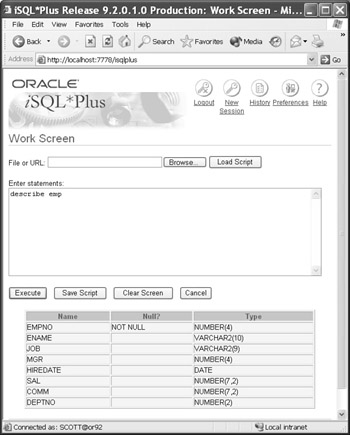The Ubiquitous SELECT Statement
The Ubiquitous SELECT Statement
In the examples of tools for running SQL, you’ve seen the following simple SELECT statement:
select * from dept;
In its most basic form, the SELECT statement has a list of columns to select from a table, using the SELECT ... FROM syntax. The * means "all columns." To successfully retrieve rows from a table, the user running the query must either own the table or have the permissions granted to the user by the owner or a DBA. The most basic SELECT syntax can be described as follows:
SELECT {* | [DISTINCT] column | expression [alias], ...} FROM tablename; This type of statement representation is typical of what you’ll see in Oracle documentation, and it can be very complex. Here is a summary of what the elements in the syntax representation mean:
| Element | Meaning |
|---|---|
| | | Pick one or the other |
| { } | One within this list is required |
| [ ] | Item is optional |
| … | May repeat |
| Uppercase | Keyword or command |
| italics | Variable |
Many more advanced features of the SELECT statement will be explored throughout this book. However, to begin with, let’s look at some examples of the column, alias, DISTINCT, and expression parts of a SELECT statement.
Column Specification
As you’ve seen, you can use the * character to view all columns in a table. But if the table contains too many columns to view at once, or your query only needs a small number of the total columns, you can pick the columns you need. For example, suppose that you want to view some information in the EMP table. How could you find out which columns are in this table without doing a SELECT * statement? You can use the DESCRIBE command in iSQL*Plus, as shown below.

Now that you know which columns exist in the EMP table, you realize that you really need to see only the employee number, name, and salary. Therefore, your SELECT statement should be something like this:
select empno, ename, sal from emp;
It produces results similar to the following:
EMPNO ENAME SAL ---------- ---------- ---------- 7369 SMITH 800 7499 ALLEN 1600 7521 WARD 1250 7566 JONES 2975 7654 MARTIN 1250 7698 BLAKE 2850 7782 CLARK 2450 7788 SCOTT 3000 7839 KING 5000 7844 TURNER 1500 7876 ADAMS 1100 7900 JAMES 950 7902 FORD 3000 7934 MILLER 1300 14 rows selected.
Column Renaming
In one of our earlier SQL*Plus examples, we wanted the column headers to be more readable, and we used some of the built-in features of SQL*Plus to do this. However, if your requirements for readability are fairly simple, you can use SQL’s built-in capability of column renaming, noted by the [alias] element of the SELECT syntax. Here is an example of providing aliases for the EMPNO, ENAME, and SAL columns in the EMP table. The alias is the renamed column seen in the results of the query.
select empno "Employee Number", ename "Name", sal "Salary" from emp; Employee Number Name Salary --------------- ---------- ---------- 7369 SMITH 800 7499 ALLEN 1600 7521 WARD 1250 7566 JONES 2975 7654 MARTIN 1250 7698 BLAKE 2850 7782 CLARK 2450 7788 SCOTT 3000 7839 KING 5000 7844 TURNER 1500 7876 ADAMS 1100 7900 JAMES 950 7902 FORD 3000 7934 MILLER 1300 14 rows selected.
alias
An alternate name for a column, specified right after the column name in a SELECT statement, seen in the results of the query.
Duplicate Removal
The DISTINCT keyword removes all duplicate rows from the results of a query. For example, what if you wanted to see the department numbers for the employees in the EMP table? Your query might be something like this:
select deptno from emp; DEPTNO ---------- 20 30 30 20 30 30 10 20 10 30 20 30 20 10 14 rows selected.
But what you probably want is one row for each of the departments found in the EMP table. In this case, use the DISTINCT keyword:
select distinct deptno from emp; DEPTNO ---------- 10 20 30 3 rows selected.
That’s much easier to read. You now know that all of the employees belong to one of three departments. However, there may be many other departments, which would be listed in the department (DEPT) table. Some departments may not have any employees right now. In Chapter 5, "Using Multiple Tables," you’ll learn how to execute queries on joined tables to get this kind of information.
Expressions
To finish off our analysis of the SELECT syntax, let’s look at the expression part of the SELECT statement. Let’s say we would like to see how salaries would look if everyone got a 15% pay increase. All of the information we need to see is still in one table, the EMP table, but we need to perform some kind of calculation on one of the existing fields. To calculate a 15% pay increase, we need to not only see the existing salary, but we also need to multiply the SAL column by 1.15:
select empno, ename, sal, sal*1.15 from emp; EMPNO ENAME SAL SAL*1.15 ---------- ---------- ---------- ---------- 7369 SMITH 800 920 7499 ALLEN 1600 1840 7521 WARD 1250 1437.5 7566 JONES 2975 3421.25 7654 MARTIN 1250 1437.5 7698 BLAKE 2850 3277.5 7782 CLARK 2450 2817.5 7788 SCOTT 3000 3450 7839 KING 5000 5750 7844 TURNER 1500 1725 7876 ADAMS 1100 1265 7900 JAMES 950 1092.5 7902 FORD 3000 3450 7934 MILLER 1300 1495 14 rows selected.
To make the proposed salary column more readable, we could use either a column alias or iSQL*Plus column-formatting commands. We might also want to show a total for the SAL and SAL*1.15 columns, or show each salary increase to exactly two decimal places. Some of these more advanced formatting techniques will be covered in Chapter 9, "Reporting Techniques."